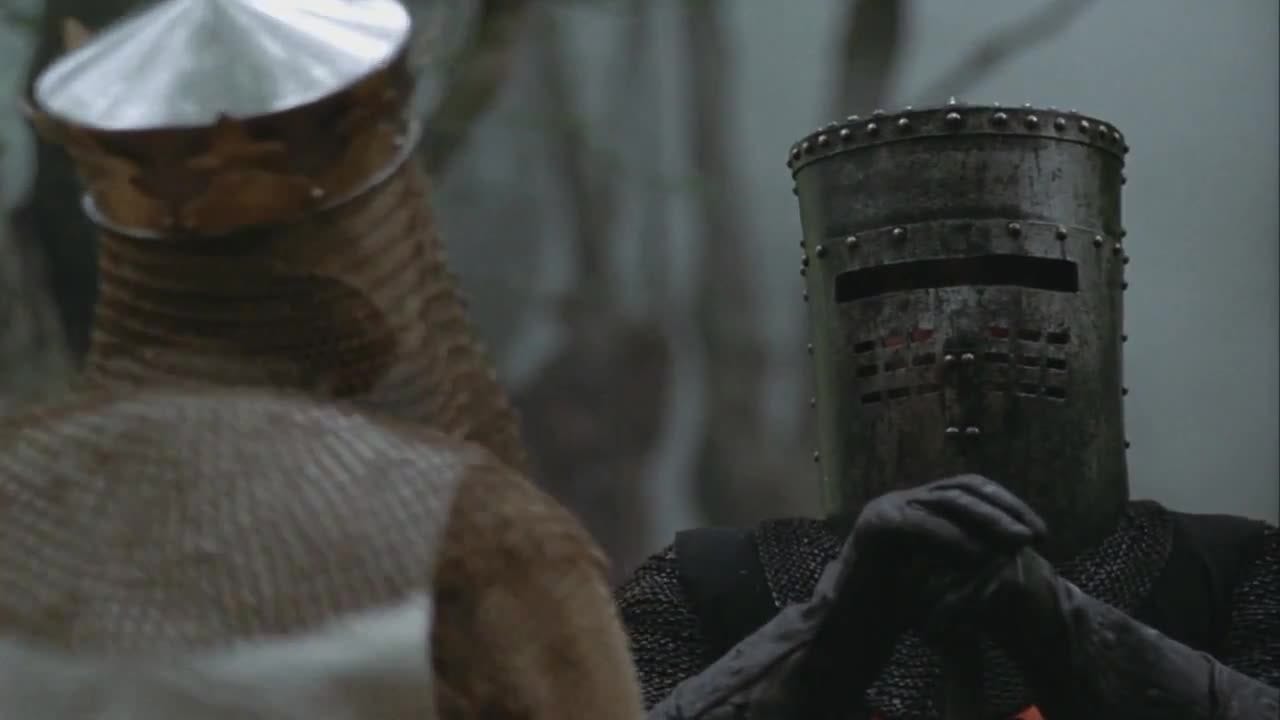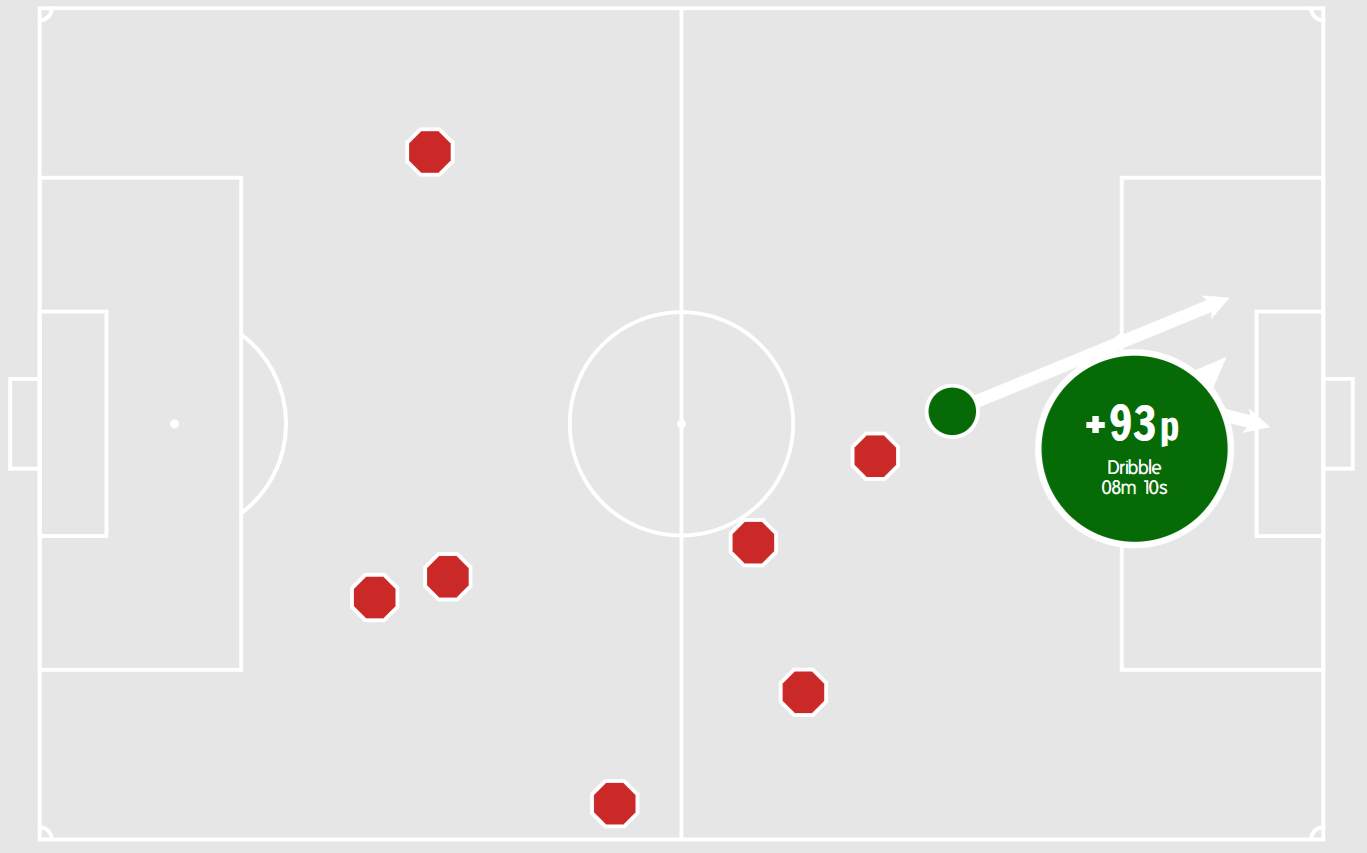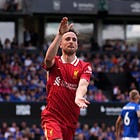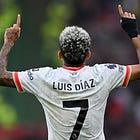New Look Liverpool: None Shall Pass
Arne Slot's Liverpool are restricting opposition dribblers like never before.
It was widely assumed the Liverpool of Arne Slot would be more solid than the version we saw in the final two seasons of Jürgen Klopp. As it took 243 minutes of 2024/25 before an opposition side had an Opta-defined big chance against the Reds in open play, the prediction appears to have been correct.
Some managers would achieve solidity through possession, delivering the sterile domination we saw from, say, Brendan Rodgers’ Swansea team or his earliest iteration of Liverpool. As yet that hasn’t been the case this season, though; the Reds have averaged 57 per cent possession this term, down from 61.3 in 2023/24.
They are taking greater care of the ball when they have it, as evidenced by setting a pass completion record in the 2-0 win over Brentford. Liverpool are also allowing far fewer opposition players to dribble past them, which was a serious problem in the final campaign of the Klopp era.
A hat-tip here to subscriber Mobykidz, who noted in the comments section of an article on Slot’s suitability for Liverpool that the Reds had struggled really badly in terms of opponent take-ons. The eye test betrayed that they were too open at times but the full extent of the issue, at least according to the data, had escaped me.
Opposing players attempted 861 take-ons against Liverpool last season. It was the worst tally across the big five leagues of Europe. While the success rate for completing them wasn’t the highest, the sheer volume ensured the Reds were dribbled past more time than any other team in the top flights of England, France, Germany, Italy or Spain.
The value or cost of being dribbled past is debatable. Liverpool conceded six goals last season which, per FBRef, contained a take-on in the penultimate two actions prior to the shot. These included conceding in draws at Manchester City and Aston Villa (twice), so arguably cost points.
But then the value of a completed take-on alone isn’t huge. Per Twelve Football, dribbling past an opponent at the edge of their penalty area only increases a team’s chance of scoring by approximately nine per cent.
“This chimed with a finding from our own tracking model: dribbling sometimes looks like a bad thing,” wrote Liverpool’s former head of research Ian Graham in his fascinating new book. He was commenting in reference to players losing valuable space, as an attempted dribble draws a defender towards the person in possession. “The real value comes at the end of the dribble. When a pass is made after a successful dribble, it is into more space than usual.”
City’s Jeremy Doku provided a case study of this when his side drew 1-1 with the Reds at the Etihad last season. He completed 12 take-ons, the joint-10th most in a big league match across the last seven seasons. One of them led to him taking a shot worth just 0.04 expected goals himself, two others enabled him to create the Cityzens’ second and third highest value chances of the contest. Most of them led to nothing much of note whatsoever.
With the data in the public sphere, there’s no way to know exactly how costly it was for Liverpool to be dribbled past 11.2 times per match in 2023/24. However, they allowed their opponents 33% more expected threat (xT) per 90 (per Mark Stats) than Arsenal or City, who saw opponents carry the ball past their players four and five times fewer a match respectively. At least some of the xT margin must be accounted for in that differential somewhere.
And so, to the big win on the defensive side for Slot in 2024/25. His new charges have been dribbled past 5.7 times per game; three times by Ipswich, six by the Bees and eight by Manchester United. Watch that trend, Arne, even if it’s still a reduction of almost 50 per cent on last season.
Yet the dribbles attempted rate has only come down by around 21 per cent. The volume is largely still there, opposing players just aren’t getting past Red men as often.
Liverpool have been dribbled past by 31.5 per cent of opposition attempts this season. No team had a better figure than 39.4 in the Premier League between 2017/18 and last term, strongly implying the Reds’ current rate is unsustainable.
Perhaps Feyenoord’s 45.3 failure percentage in 2023/24 - better than Klopp’s side mustered in any of his final seven campaigns - is a realistic aim. This figure isn’t everything, though; Liverpool had worse rates in their best recent seasons, it’s just the volume which has grown out of control.
But consider this: Liverpool have failed to tackle 17 dribblers in total across three games this season. Bournemouth, Luton and Wolves all succeeded with 18 attempted take-ons in single matches with Klopp’s men last season, with Aston Villa and City notching 17. Based on the two actions leading to each of the shots Slot’s side have conceded, only two featured a take-on, with the pair of goal attempts collectively worth a mere 0.15 expected goals. They are exactly the same group of players without exception, so the structure and set up implemented by the new head coach looks the likely cause of the improvement.
There will be harder days ahead. Ipswich are bottom of the division for dribbles attempted with Brentford only three places higher. But the Reds have won at least 61.9 per cent of their challenges against dribblers in all three matches when they only did this four times in total in the previous campaign.
It has been a team effort too. Where only one Liverpool player with at least 180 minutes has lost more than 1.2 dribble challenges per 90 this season, eight did in 2023/24. Even the man in question - Alexis Mac Allister - has dropped his rate from 2.3 to 1.7 so has made an improvement. Notably, Ryan Gravenberch has been dribbled past just once, a statistic which highlights how well he is doing in his new Liverpool position.
“Whoever you play, you have to win challenges. It’s something I already mentioned in the dressing room and I will mention it again,” Klopp said after a 2-2 draw with Wolves in 2023, a match at Anfield in which the visitors completed 10 dribbles on their way to winning 55 per cent of the ground duels. It appears it needed a tactical tweak rather than a stern word from Jürgen to achieve the effect for which he was looking.








Crazy stuff. To the wider lens view of it almost gives a sense of security that I’ve never had as a liverpool supporter. And to put it to effect in my opinion this way of playing gives us a much better chance of winning the league.
Thanks Beez for scratching the dribbling itch. That helpfully sets this in some context. How much of it was a conscious choice last season is up for debate though the stats make me lean more to it was in some games with data showing it had less impact goal wise. But reducing those numbers are a sign of a more compact system where our wide men are tracking back and midfielders are coming across to cover or intervene. If you win games early and not look like conceding that helps. Our opponents take on stats are inflated by United coming at us when we were 3-0 up. So game state can be a factor though last season was more a roller coaster. There's a long way to go and with Champions League it will be interesting to see how you strike the balance to conserve fitness.